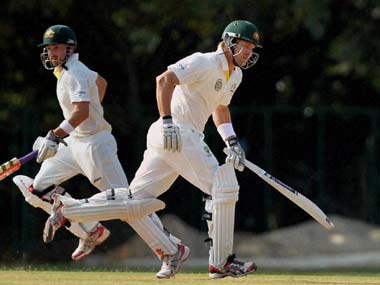Eighteen. That is how many Australian batsmen have fallen prey to Indian spinners in the two completed innings from the warm-up games. That’s 90% of the visiting wickets to fall. The spinners that took these wickets aren’t exactly household names either, though Parvez Rassol is getting there after taking 7 for 45 in the first game. For India ‘A’ Rakesh Dhurv and Jalaj Saxena combined to take 9 for 112, as Australia succumbed for 235 in pursuit of 451. Manoj Tiwary, who made a hundred for India ‘A’, was forthright in his assessment of Australia’s struggles. “They haven’t played the spinners as well as they could have - because I think the technique was wanting. They were not sure of their defence to be honest. That’s why they were not stretching enough to play the spin and not going back enough to play their shots.” Admittedly, Michael Clarke, Australia’s captain and best player of spin, did not play either game. But with Australia not quite a settled side, their failures against the turning ball would have rung alarm bells in the visiting think tank and created that crucial bit of doubt in a batsman’s mind. [caption id=“attachment_629376” align=“alignright” width=“380”]  Australia’s batsmen need to follow Shane Watson’s lead. PTI[/caption] It would also have given the Indian think tank a blueprint for how to bowl to the Aussies. Once a weakness has been exposed, it must be ruthlessly exploited. Harbhajan Singh did that brilliantly back in 2001, when he turned Ricky Ponting into Chris Martin. The success of the spinners stands out for another reason - India chose not to play any in the warm-up games against England. The theory then was it would deny England an opportunity to work out how to play spin in India. That logic does not seem to be in play anymore and these results suggest it should never have been the case. It is far better to back your own strengths and probe an opponent’s weakness early in order to gain the psychological upper hand. Shane Watson, the only Australia batsman who was at ease against the spinners, offered a determined riposte, saying that spinners cannot be allowed “to settle in a certain line and length and allow them to be able to bowl that ball over and over again”. But batsmen can only do that when they are confident of their method. Doubt, in any form, is the spinner’s best weapon. Again, we go back to Tiwary’s assessment: “If this is the way they are going to bat, it’s going to be difficult for them to be honest… to face quality spinners like Bhajjupa (Harbhajan Singh) and Ashwin and Ojha. The way they are bowling, it will be very difficult for them." The other take-aways from the tour game also fall in India’s favour. Australia’s seamers struggled to take wickets against India ‘A’ and if the Chepauk pitch is anything like this one at the Guru Nanak Ground, then they can expect more of the same. Their spinners too lacked penetration. While Lyon did take a few wickets, he was taken for runs at will, as was the 19-year-old Ashton Agar. Agar was being tipped for a surprise Test debut, but his figures of 3 for 105 from 20 overs might just have put that idea to bed.
India chose not to play any spinner in the warm-up games against England. The theory then was it would deny England an opportunity to work out how to play spin in India. That logic does not seem to be in play anymore.
Advertisement
End of Article
Written by Tariq Engineer
Tariq Engineer is a sports tragic who willingly forgoes sleep for the pleasure of watching live events around the globe on television. His dream is to attend all four tennis Grand Slams and all four golf Grand Slams in the same year, though he is prepared to settle for Wimbledon and the Masters. see more


)

)
)
)
)
)
)
)
)



